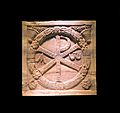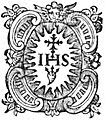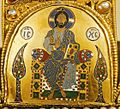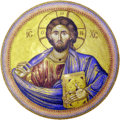Christogram IHS facts for kids
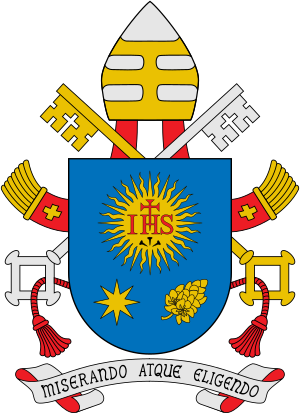
The Christogram IHS is a special symbol or monogram that stands for Jesus Christ. It's a way to represent Jesus using just a few letters.
This symbol comes from the Greek language. It's a shortened version of the name IHΣΟΥΣ, which is how "Jesus" is written in Greek.
In the Eastern Orthodox Church, a different Christogram is often used. It's made with the Greek letters X, P, I, and X. These are the first letters of the Greek words for "Christ" and "Jesus Christ."
In Western cultures, you'll often see "IHS" or "IHC." These letters are the first three letters (iota-eta-sigma) of Jesus's name in the Greek alphabet: ΙΗΣΟΥΣ. The "IHS" symbol first appeared on coins made by Emperor Justinian II around the late 600s and early 700s.
What IHS Means
The Society of Jesus, also known as the Jesuit order, officially adopted "IHS" as their symbol in the 1600s. Over time, people also came up with Latin meanings for the "IHS" abbreviation. These include:
- Iesus Humilis Societas – meaning "Humble Society of Jesus."
- Iesus Hominum Salvator – meaning "Jesus, Savior of men."
Another famous saying connected to "IHS" is:
- In hoc signo vinces – meaning "By this sign you shall conquer."
These longer meanings likely came about because in the Middle Ages, people sometimes mistook the Greek letter 'eta' (which looks like an 'H') for the Latin letter 'E'.
There's a well-known legend about the phrase "In hoc signo vinces." It says that Emperor Constantine the Great saw this inscription, along with a cross, in a dream. This happened before a big battle against Maxentius in the year 312, near the Ponte Milvio.
Some people have suggested that the "IHS" symbol might come from ancient Egyptian mythology, linking it to gods like Isis, Horus, and Seth. However, there is no scientific or historical proof to support these ideas. The symbol's true origin is from the Greek name of Jesus.
Images for kids
-
Chi-Rho symbol with Alpha and Omega on a 4th-century sarcophagus (Vatican Museums)
-
A Chi Rho combined with Alpha and Omega, in 1669 labelled Chrismon Sancti Ambrosii, Milan Cathedral
-
IHC monogram from Clontuskert Abbey, Ireland
-
Christ Pantocrator on the Holy Crown of Hungary (12th century)
See also
 In Spanish: Cristograma para niños
In Spanish: Cristograma para niños



